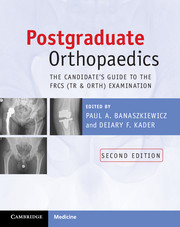Book contents
- Frontmatter
- Contents
- Contributors
- Foreword
- Preface to second edition
- Abbreviations
- Section 1 The FRCS (Tr & Orth) examination
- Chapter 1 General advice for the FRCS (Tr & Orth)
- Section 2 The written paper
- Section 3 The clinicals
- Section 4 The adult elective orthopaedics oral
- Section 5 The hand oral
- Section 6 The paediatric oral
- Section 7 The trauma oral
- Section 8 The basic science oral
- Section 9 Miscellaneous topics
- Index
- References
Chapter 1 - General advice for the FRCS (Tr & Orth)
from Section 1 - The FRCS (Tr & Orth) examination
- Frontmatter
- Contents
- Contributors
- Foreword
- Preface to second edition
- Abbreviations
- Section 1 The FRCS (Tr & Orth) examination
- Chapter 1 General advice for the FRCS (Tr & Orth)
- Section 2 The written paper
- Section 3 The clinicals
- Section 4 The adult elective orthopaedics oral
- Section 5 The hand oral
- Section 6 The paediatric oral
- Section 7 The trauma oral
- Section 8 The basic science oral
- Section 9 Miscellaneous topics
- Index
- References
Summary
The FRCS (Tr & Orth) is the major obstacle in higher surgical training. It is regarded as a fair but very probing examination. Passing depends on knowledge, performance on the day and a bit of luck. However, as with all exams, preparation is the key to success. That preparation should encompass not only reading to accumulate facts, but should include clinical experience, history-taking, clinical examination and, most of all, practice. This section acts as an introduction to the current format of the FRCS (Tr & Orth) and serves to provide prospective candidates with some helpful hints and top tips. This advice is based on our own personal experiences, those of our colleagues, our previous trainers and current trainees.
Examination format
The current FRCS (Tr & Orth) encompasses two sections: section 1 is the written exam and section 2 the clinical and oral exam. For further details and to ensure no further changes have been made following this publication, we suggest all candidates carefully review the Intercollegiate Specialty Board (ISB) website (http://www.intercollegiate.org.uk).
- Type
- Chapter
- Information
- Postgraduate OrthopaedicsThe Candidate's Guide to the FRCS (Tr and Orth) Examination, pp. 1 - 8Publisher: Cambridge University PressPrint publication year: 2012



